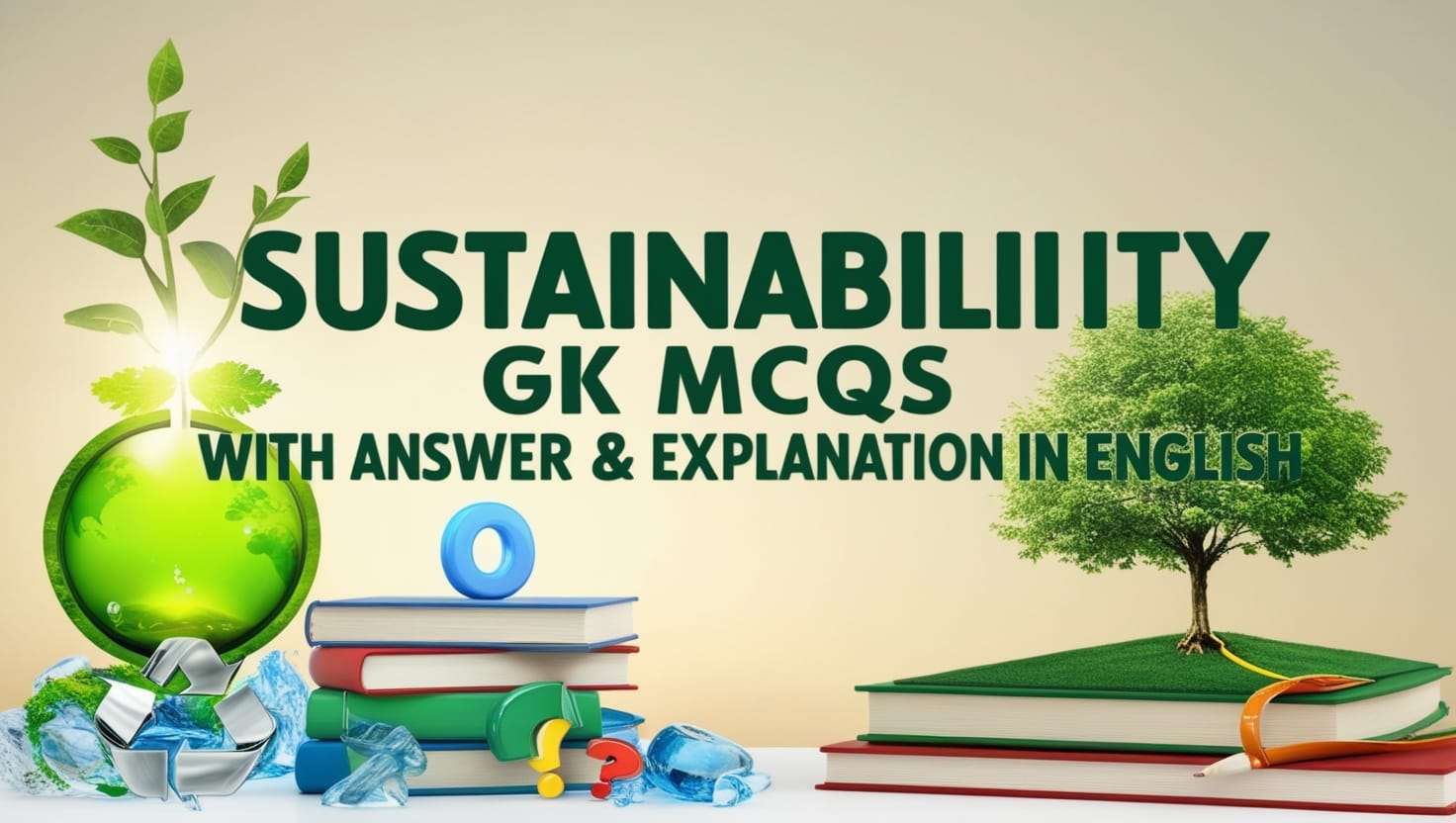
In this article, we delve into key topics surrounding sustainability, featuring a comprehensive set of GK MCQs with answers and detailed explanations. Whether you’re preparing for exams or simply looking to enhance your knowledge, these questions cover various aspects of sustainability, from environmental conservation to sustainable development.
Explore the world of sustainability with our insightful and informative questions, designed to provide a deeper understanding of this crucial subject.
1. Which among the following property of Shale Gas makes it a potential replacement to the conventional Natural gas?
- Its distinct Chemical Property which makes it less polluting
- Its distinct physical property which makes it easy to store & handle
- Its availability in huge reserves
- None of the above
Show Answer
Answer: Its availability in huge reserves
Shale gas has gained popularity in the global gas exploration market due to its abundance and cost-effective production methods. Shale gas is natural gas that is trapped within shale rock formations. Recent advancements in hydraulic fracturing (fracking) and horizontal drilling techniques have made it possible to extract natural gas from these previously inaccessible reserves. Shale gas has become an important source of energy in countries like the United States, contributing to their energy independence. However, the extraction of shale gas is not without controversy, as it raises environmental and social concerns related to water usage and potential groundwater contamination.
2. One of the major objectives of the National Water Mission is to increase the water use efficiency by 20%. Which among the following is the correct definition of water use efficiency?
- Increase the ground water level by proper management of rainwater
- To make the irrigation facilities to maximum crop areas
- To save water from evaporation and runoff or subsurface drainage
- To make bodies of water clean and usable for drinking purposes
Show Answer
Answer: To save water from evaporation and runoff or subsurface drainage
Water use efficiency refers to the effective utilization of water resources while minimizing losses due to evaporation, runoff, or subsurface drainage. It involves techniques and practices that aim to optimize the use of available water for various purposes, including agriculture, industry, and domestic use. Improving water use efficiency is crucial for sustainable water management, especially in regions facing water scarcity. Strategies may include advanced irrigation methods, water recycling, and reducing water wastage.
3. Which among the following is the main source of “Synthetic Fuel”?
- Plastic
- Biomass
- Coal
- Municipal Waste
Show Answer
Answer: Coal
Synthetic fuel, often referred to as synfuel, is produced from non-petroleum sources such as coal, natural gas, or biomass. It is a liquid or gaseous fuel that can serve as an alternative to conventional fossil fuels like gasoline and diesel. Synthetic fuels can be produced through various processes, including coal liquefaction, gas-to-liquids (GTL), and biomass-to-liquids (BTL). They offer a way to reduce dependence on traditional fossil fuels and mitigate greenhouse gas emissions.
4. Fish meal is widely used as which among the following?
- Cost-effective Food
- Poultry Feed Additive
- Organic Fertilizer
- Bird food
Show Answer
Answer: Poultry Feed Additive
Fish meal is a nutrient-rich product created by grinding and cooking fish, typically unfit for direct human consumption. It is commonly used as an additive in animal feeds, particularly for poultry and aquaculture. Fish meal is a valuable protein source and provides essential nutrients for livestock and fish. It is often favored for its high protein content, amino acids, and omega-3 fatty acids, which contribute to the growth and health of animals.
5. With which among the following subjects does the Agenda 21, that came out of Earth Summit 1992, explicitly deal?
- Green House Gases
- Climate Changes
- Sustainability
- Ozone Layer Protection
Show Answer
Answer: Sustainability
Agenda 21 is a comprehensive action plan developed at the United Nations Conference on Environment and Development, which took place in Rio de Janeiro in 1992. It focuses on the concept of sustainable development and provides guidelines and recommendations for countries to address various environmental and developmental challenges. Agenda 21 aims to promote social, economic, and environmental sustainability by outlining strategies for sustainable resource management, poverty reduction, and environmental protection. It has served as a blueprint for numerous sustainability initiatives worldwide.
6. The Jatropha curcas, a source of inedible vegetable oil used to produce biofuel and works as a carbon sink, is native to which of the following regions of the world?
- Europe
- Central Africa
- Central America
- South America
Show Answer
Answer: Central America
Jatropha curcas is a plant native to Central America and other tropical regions. It has gained attention as a source of biofuel due to the oil-rich seeds it produces. The oil extracted from Jatropha seeds can be used for biodiesel production, making it an attractive option for renewable energy. Additionally, Jatropha cultivation can serve as a carbon sink, as it absorbs carbon dioxide from the atmosphere, contributing to carbon sequestration efforts.
7. Along with Jatropha, the seed oil of which among the following plants has been found to be useful in diesel generators being explored in hundreds of projects throughout India and other developing countries as feedstock for biodiesel?
- Arachis hypogea
- Pongamia pinnata
- Butea monosperma
- Pterocarpus santalinius
Show Answer
Answer: Pongamia pinnata
Pongamia pinnata is a tree known for its oil-rich seeds, which have been found useful in applications such as diesel generators and biodiesel production. The oil from Pongamia seeds can be processed into biodiesel, offering an environmentally friendly alternative to conventional diesel fuel. This tree’s cultivation may play a role in sustainable energy production.
8. The Hydroponics is most closely related to which among the following?
- Grafting of Plants
- Water conservation
- Study of Vegetable
- Soilless culture of Plants
Show Answer
Answer: Soilless culture of Plants
Hydroponics is a method of growing plants without soil. Instead, plants are grown in a nutrient-rich water solution or a growing medium. This technique enables precise control of plant nutrition and environmental conditions, leading to improved water and resource efficiency. Hydroponics is particularly valuable in areas with limited arable land or in urban agriculture settings.
9. Earth Hour, organized by which organization?
- UNESCO
- Earth Hour Foundation
- World Wildlife Fund
- United Nations Environment Programme
Show Answer
Answer: World Wildlife Fund
Earth Hour is an annual event organized by the World Wildlife Fund (WWF). During Earth Hour, participants around the world are encouraged to turn off non-essential lights and electrical appliances for one hour to raise awareness about climate change and environmental issues. It symbolizes a collective commitment to energy conservation and the need for action on climate change.
10. Which among the following terms of utmost significance in the dynamics of resource management was coined in the ‘Brundtland Commission Report’?
- Polluter-Pays Principle
- Sustainable development
- Inclusive Growth
- Carrying Capacity
Show Answer
Answer: Sustainable development
The term “sustainable development” was coined in the Brundtland Commission Report, which highlighted the need for development that meets the needs of the present without compromising the ability of future generations to meet their own needs.







